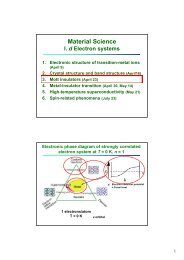Thesis High-Resolution Photoemission Study of Kondo Insulators ...
Thesis High-Resolution Photoemission Study of Kondo Insulators ...
Thesis High-Resolution Photoemission Study of Kondo Insulators ...
Create successful ePaper yourself
Turn your PDF publications into a flip-book with our unique Google optimized e-Paper software.
38 Chapter 3. <strong>Photoemission</strong> <strong>Study</strong> <strong>of</strong> YbB12 with Variable Photon Energies<br />
Intensity (arb. units)<br />
LDA<br />
B p DOS<br />
YbB 12<br />
hν = 21.2 eV<br />
Au<br />
0.10 0.00 -0.10<br />
Binding Energy (eV)<br />
Figure 3.5: He I spectrum <strong>of</strong> YbB12 in the vicinity <strong>of</strong> EF . The solid curves is the<br />
spectrum <strong>of</strong> Au evaporated onto the sample. The B p partial DOS given by the LDA<br />
band-structure calculation broadened by the instrumental resolution is also shown.<br />
study <strong>of</strong> the Anderson lattice as a model for a <strong>Kondo</strong> insulator [3.22].<br />
Therefore, we expect that the Yb 4f spectral lineshape is likewise subject to the<br />
strong renormalization <strong>of</strong> energy bands. Instead <strong>of</strong> first-principles approaches such<br />
as second-order perturbation calculations [3.23], we have employed a phenomenological<br />
approach and fitted the observed spectral lineshape using a model self-energy correction.<br />
As shown in Fig. 3.6 by the dashed curve, the Yb f partial DOS has structures from<br />
∼150 to ∼400 meV while the observed peak position is ∼40 meV below EF . This peak<br />
exhibits a steep rise from EF as in the case <strong>of</strong> the B 2p-derived He I spectrum, and<br />
a slow tailing <strong>of</strong>f on the higher binding energy side, resulting in a highly asymmetric<br />
lineshape. This indicates that the band narrowing is energy dependent and is stronger<br />
near EF . The model self-energy which we have employed to calculate the 4f spectral<br />
function ρf(ω) is <strong>of</strong> the same type as that previously used for FeSi [3.13]:<br />
where<br />
Σh(ω) =<br />
Σ(ω) =Σh(ω)+Σl(ω)+Σl ′(ω), (3.1)<br />
gh(ω − δ)<br />
,<br />
(ω − δ + iγh) 2






